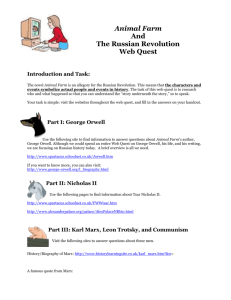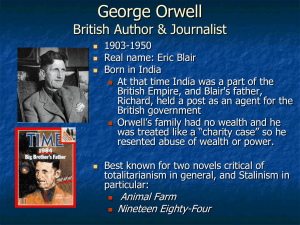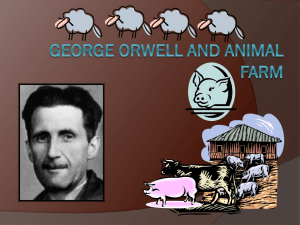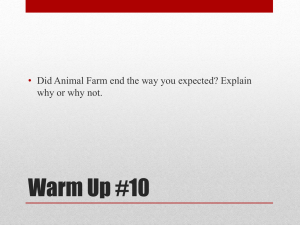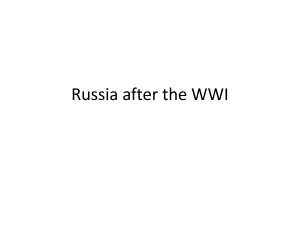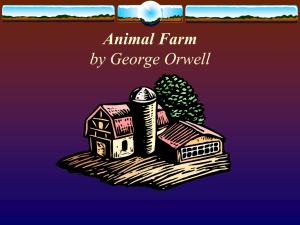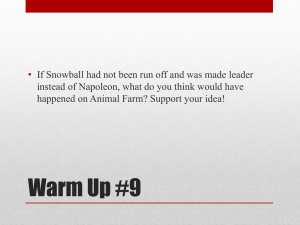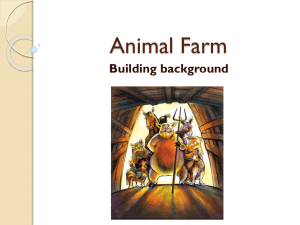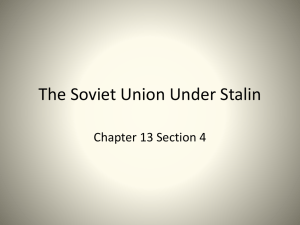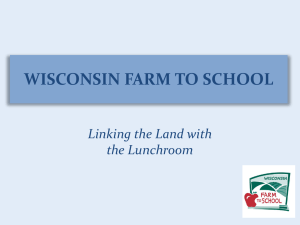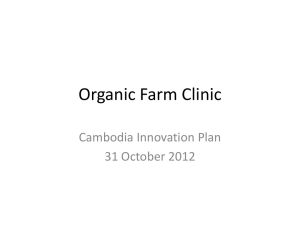Animal Farm and Russian Revolution
advertisement
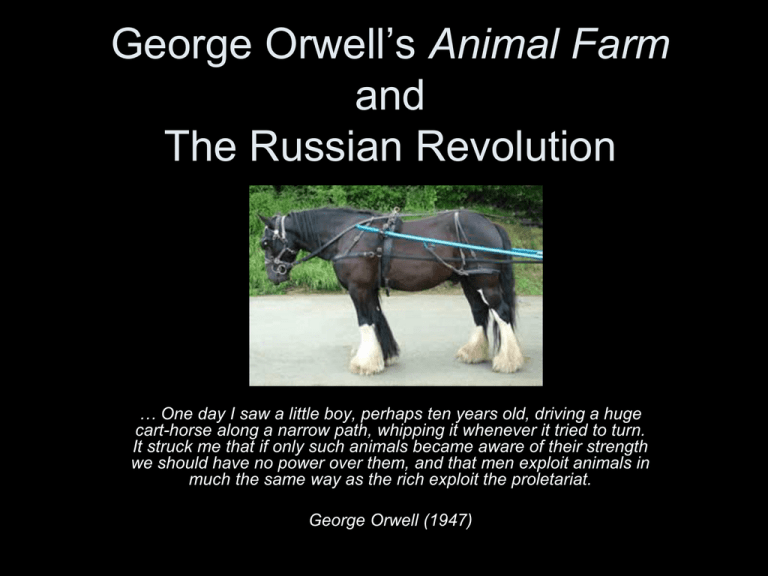
George Orwell’s Animal Farm and The Russian Revolution … One day I saw a little boy, perhaps ten years old, driving a huge cart-horse along a narrow path, whipping it whenever it tried to turn. It struck me that if only such animals became aware of their strength we should have no power over them, and that men exploit animals in much the same way as the rich exploit the proletariat. George Orwell (1947) • Things are about to get a little strange on Manor Farm. • Farmer Jones has just locked up the henhouse and stumbled off to bed, thinking all is well in his barnyard. • He probably wouldn’t believe the events that are about to unfold in the barn. • Old Major, Mr. Jones’s prize-winning boar, has just gathered the animals together for a meeting. • Pigs, hens, horses, dogs, ducks, and goats congregate to listen to Old Major share his dream. • Humans are the enemy, Old Major tells his fellow farm animals. They produce nothing, yet they own everything. • Animals, however, work their whole lives for their masters. They receive only enough food to keep them working. • Old Major believes that someday this will all change. – Animals will work together to overthrow their oppressors. – Animals will create their own farm where they will live and work in harmony, plenty, and equality. – The days of slavery will end. – The rebellion will come. – Every animal must be ready! Will Manor Farm become the first true … Animal Farm?! • George Orwell wrote Animal Farm between November 1943 and February 1944. • He wrote a preface to this novel that was never published. In the preface, he explained his purpose in writing Animal Farm. – He was angry that people in Europe admired Soviet Russia. – He wanted to write a critical novel about Joseph Stalin. Literary Form • George Orwell decided to write Animal Farm in the form of a fairy story, or fairy tale. – A fairy tale is usually written for children about magical or fantastic events that are not true. – Orwell originally subtitled Animal Farm “a fairy story” in order to stress that it was fantastic, but unfortunately, it was not untrue. • The literary form of the animal fable has been used for centuries. – Animal fables are short stories that teach a moral lesson. They include animals that often talk and act like humans. (Ex: Aesop’s fables) • Animal fables soon developed into more complex forms of literature called allegories. – An allegory is a story that includes characters, setting, etc. that have both literal and figurative meanings. Literal and Figurative Meaning in Animal Farm • George Orwell’s Animal Farm is an allegory. Therefore, the novel has both a literal and figurative meaning. – On the surface, Animal Farm tells the story of farm animals who are tired of obeying the orders of a cruel master. This is the story’s literal meaning. • A pig is a pig. – It is important to understand that Animal Farm also has a figurative meaning. This novel also tells the story of Soviet Russia during the Russian Revolution. • A pig is a political leader. Satire • Animal Farm is also written as a satire. – A satire is a form of literature that criticizes a subject by making it seem ridiculous, amusing, or contemptible. – Purpose of satire: • To make a moral judgment • To correct wrongs • To criticize injustices – Animal Farm makes the Soviet Union seem both laughable and despicable. Animal Farm and The Russian Revolution: A Comparison • In order to understand George Orwell’s literary masterpiece Animal Farm, you must know a few people and events that played important roles in the Russian Revolution. • • • • • Czar Nicholas II Czar Nicholas II was Russia’s last czar. He was part of the Romanov dynasty that ruled Russia for over 300 years! Czar means emperor and comes from the word Caesar. Russian czars lived in a magnificent palace called the Kremlin. Czar Nicholas was narrow-minded and incompetent. He was an autocrat – a self-appointed ruler who holds all the political power. In March 1917, there were food riots and army mutinies in Petrograd (a Russian city). Czar Nicholas couldn’t cope with the difficult situation, so he abdicated the throne. In Animal Farm … Mr. Jones = Czar Nicholas II In Animal Farm … Old Major = Karl Marx Karl Marx • Marx believed the workers (proletarians) were the true producers of wealth. But the capitalists (bourgeoisie) owned the means of production – land and industry. Therefore, the capitalists made huge profits while the workers earned just enough to survive. Not fair! • Marx called for “workers of the world” to unite against their capitalist oppressors. • Marx believed that eventually the proletariat would become so numerous and so impoverished that they would rise up against the capitalist system throughout the world. • • • • Leon Trotsky Trotsky was a brilliant intellectual and speaker who organized the Red Army and led it to victory against the White Armies in the Civil War of 1918-1919. Trotsky and Stalin disagreed on Russia’s future. Trotsky wanted the Communist revolution to be worldwide. Stalin wanted to protect the Soviet Union from outside forces (keep communism in the USSR). Stalin defeated Trotsky at the Communist Party Congress in 1927 and gained control of the secret police. Trotsky was chased away by the KGB (secret police) and fled to Mexico City, where a Soviet agent killed him with an axe in 1940. In Animal Farm … Snowball = Leon Trotsky • • • • In Animal Farm … Napoleon = Joseph Stalin Joseph Stalin While most Russian leaders belonged to the middle-class, Joseph Stalin was born into the peasant class. Unlike Trotsky, Stalin was not welleducated and could not discuss Marxist theory on a sophisticated level. Stalin was named General Secretary of the Communist Party in 1922. He was in charge of dull paperwork for the Communist party. Though this position seemed unimportant, Stalin used his position as secretary to gain supporters for his future rise to power. He eventually defeated Trotsky in the struggle for power. • Under Joseph Stalin, the country fell under totalitarianism – a form of government with strong central rule that tries to control individual freedoms. – Stalin instituted the “Five Years Plan” to increase economic growth, but ordered farms to give most of their produce to the government. – Peasants often slaughtered their animals and burned down their farm buildings rather than give them to the Soviets! – Peasants who opposed Stalin were sent to labor camps, deported, or executed. – The Five-Year Plan created a man-made famine. Five million people starved to death or were executed as a result! Moscow Purge Trials • By 1936, Stalin began to use what would become known as the Moscow Purge Trials to control workers. – In 1936, sixteen prominent and loyal Communists publicly confessed to unbelievable crimes – spying, terrorism, and plotting with Leon Trotsky. • There was no evidence of their guilt other than the confessions. • All sixteen were immediately executed. – About 70% of the Party leadership became victims of the Great Purge. – These trials served as an example of what would happen to people if they opposed Stalin. • Although exact figures cannot be determined, some historians have estimated that Joseph Stalin may have killed as many as 20 million people! • To put this into perspective, consider the fact that Adolf Hitler is believed to have killed 11 million people in the Holocaust!
